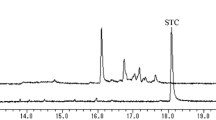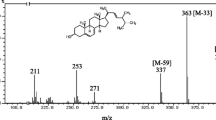Abstract
The mycotoxin sterigmatocystin (STC) is produced mainly by some Aspergillus and Penicillium fungi; it naturally contaminates cereals, peanuts, and products derived from these crops, and is both mutagenic and carcinogenic. As an intermediate of aflatoxin (AF) biosynthesis, its structure is similar to that of AF. Although immunoaffinity columns (IACs) are a popular approach to sample clean-up, no IAC is commercially available for STC, but a commercially available IAC for AF shows cross reactivity to STC. We here developed a new method for analyzing STC in grains using such an IAC and liquid chromatography mass spectrometry (LCMS), and validated this method using six different grains. The STC limit of detection (signal-to-noise ratio, S/N = 3) was 2.5 pg (1.0 μg/kg in the product), and the calibration curve was linear in the range of 7.5–375 pg (3.0–150 μg/kg in the product). The within-day recovery of STC from samples spiked with STC at 5.0 and 50 μg/kg was 83.2–102.5 % and the RSDr (relative standard deviation of repeatability) of these samples was 1.9–6.5 %; the RSDr of STC-pretreated grain samples was 3.1–14.0 %. Average recovery of STC from samples spiked with STC in the range of 5.0–100 μg/kg STC was 83.2–102.5 %, with an RSDr of 0.24–6.5 %; the RSDr of STC-pretreated grain samples was 2.4–14.0 %. In an intermediate precision study, the average STC recovery from STC-spiked samples by three analysts was 95.2–107.5 %, with RSDRi (intermediate precision) of 4.0–7.1 %; the RSDRi of the STC-pretreated samples was 4.8–10.4 %. Thus, the proposed method was effective for STC analysis in grains, and holds potential for a novel application of a commercial IAC, intended for AFs, in STC analysis.


Similar content being viewed by others
References
Abd Alla EAM, Metwally MM, Mehriz AM, Abu Sree YH (1996) Sterigmatocystin: incidence, fate and production by Aspergillus versicolor in Ras cheese. Nahrung 40:310–313
Abdel-Mallek AY, El-Maraghy SSM, Hasan HAH (1993) Mycotoxin-producing potential of some Aspergillus, Penicillium and Fusarium isolates found on corn grains and sunflower seeds in Egypt. J Islam Acad Sci 6:189–192
AOAC International (2005) AOAC Official Method 973.38 Sterigmatocystin in barley and wheat thin-layer chromatographic method. Official methods of analysis of AOAC International, 18th edn. AOAC International, Gaithersburg
Barnes SE, Dola TP, Bennett JW, Bhatnagar D (1994) Synthesis of sterigmatocystin on a chemically defined medium by species of Aspergillus and Chaetomium. Mycopathologia 125:173–178
European Food Safety Authority (2013) Scientific opinion on the risk for public and animal health related to the presence of sterigmatocystin in food and feed. EFSA J 11:3254
Engelhart S, Loock A, Skutlarek D, Sagunski H, Lommel A, Farber H, Exner M (2002) Occurrence of toxigenic Aspergillus versicolor isolates and sterigmatocystin in carpet dust from damp indoor environments. Appl Environ Microbiol 68:3886–3890
Food and Agriculture Organization (2004) Worldwide regulations for mycotoxins in food and feed in 2003. FAO Food and Nutrition Paper 81. United Nations, Rome
Frisvad JC, Samson RA, Smedsgaard J (2004) Emericella astellata, a new producer of aflatoxin B1, B2 and sterigmatocystin. Lett Appl Microbiol 38:440–445
International Agency for Research on Cancer (1976) Some naturally occurring substances. IARC monographs on the evaluation of the carcinogenic risk of chemicals to man, vol 10. IARC, Lyon
International Agency for Research on Cancer (1987)Overall evaluations of carcinogenicity: an updating of IARC monographs volumes 1 to 42. IARC monographs on the evaluation of the carcinogenic risks to humans, suppl 7. IARC, Lyon
Jurjevic Z, Peterson SW, Solfrizzo M, Peraica M (2013) Sterigmatocystin production by nine newly described Aspergillus species in section Versicolores grown on two different media. Mycotoxin Res 29:141–145
Li S, Chen PY, Marquardt RR, Han Z, Clarke JR (1996) Production of a sensitive monoclonal antibody to sterigmatocystin and its application to ELISA of wheat. J Agric Food Chem 44:372–375
Nielsen KF, Gravesen S, Nielsen PA, Andersen B, Thrane U, Frisvad JC (1999) Production of mycotoxins on artificially and naturally infested building materials. Mycopathologia 145:43–56
Purchase IFH, Van Der Watt JJ (1970) Carcinogenicity of sterigmatocystin. Food Cosmet Toxicol 8:289–295
Sekijima M, Whong D, Watabe H, Sugai K, Sekita S, Ueno Y (1992) Mutagenicity of sterigmatocystin and related compounds. Mutat Res 272:281–292
Sugimoto T, Minamisawa M, Takano K, Sasamura Y, Tsuruta O (1977) Detection of ochratoxin A, citrinin and sterigmatocystin from storaged rice by natural occurrence of Penicillium viridicatum and Aspergillus versicolor. Food Hyg Saf Sci 18:176–181
Tanaka K, Sago Y, Zheng Y, Nakagawa H, Kushiro M (2007) Mycotoxins in rice. Int J Food Microbiol 119:59–66
Uchigashima M, Saigusa M, Yamashita H, Miyake S, Fujita K, Nakajima M (2009) Development of a novel immunoaffinity column for aflatoxin analysis using an organic solvent-tolerant monoclonal antibody. J Agric Food Chem 57:8728–8734
Versilovskis A, Saeger SD (2010) Sterigmatocystin: occurrence in foodstuffs and analytical methods—an overview. Mol Nutr Food Res 54:136–147
Versilovskis A, Bartkevics V, Mikelsone V (2008a) Analytical methods sterigmatocystin presence in typical Latvian grains. Food Chem 109:243–248
Versilovskis A, Saeger SD, Mikelsone V (2008b) Determination of sterigmatocystin in beer by high performance liquid chromatography with ultraviolet detection. World Mycotoxin J 1:161–166
Versilovskis A, Peteghem CV, Saeger SD (2009) Determination of sterigmatocystin in cheese by high-performance liquid chromatography-tandem mass spectrometry. Food Addit Contam 26:127–333
Warth B, Parich A, Atehnkeng J, Bandyopadhyay R, Schuhmacher R, Sulyok M, Krska R (2012) Quantitation of mycotoxins in food and feed from Burkina Faso and Mozambique using a modern LC-MS/MS multitoxin method. J Agric Food Chem 60:9352–9363
Wehner FC, Thiel PG, Van Rensburg SJ, Demasius IPC (1978) Mutagenicity to Salmonella typhimurium of some Aspergillus and Penicillium mycotoxins. Mutat Res 58:193–203
Yabe K (1998) Biosynthetic pathways of aflatoxins. Nippon Nogeikagaku Kaishi 72:63–67
Yabe K, Nakajima H (2011) Aflatoxin biosynthesis. Food Hyg Saf Sci 52:135–147
Youssef MS, El-Maghraby OMO, Ibrahim YM (2008) Mycobiota and mycotoxins of Egyptian peanut (Arachis hypogeae L.) seeds. Int J Bot 4:349–360
Source of funding
This study was performed as a co-operation between Shinshu University and HORIBA, Ltd.
Conflict of interest
Authors declare that there is no conflict of interest for this manuscript.
Author information
Authors and Affiliations
Corresponding author
Rights and permissions
About this article
Cite this article
Sasaki, R., Hossain, M.Z., Abe, N. et al. Development of an analytical method for the determination of sterigmatocystin in grains using LCMS after immunoaffinity column purification. Mycotoxin Res 30, 123–129 (2014). https://doi.org/10.1007/s12550-014-0196-0
Received:
Revised:
Accepted:
Published:
Issue Date:
DOI: https://doi.org/10.1007/s12550-014-0196-0




